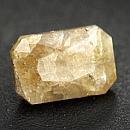|
|
||||||||||||||||
|
||||||||||||||||
|
||||||
|
|
|
|
Arrojadite-(KFe)
|
|
| | |
| Discovered in 1925; IMA status: Valid (pre-IMA; Grandfathered) | ||
|
| ||
|
Chemistry |
|
|
| |
|
KNa4Ca(Fe2+,Mn2+)14Al(PO4)12(OH)2 | |
|
|
Potassium Sodium Calcium Iron Manganese Aluminum Phosphate Hydroxide |
|
Molecular Weight: |
2,033.08 gm |
|
Composition: |
Potassium |
1.92 % |
K |
2.32 % |
K2O |
|
|
Sodium |
4.52 % |
Na |
6.10 % |
Na2O |
|
|
Calcium |
1.97 % |
Ca |
2.76 % |
CaO |
|
|
Magnesium |
2.39 % |
Mg |
3.96 % |
MgO |
|
|
Manganese |
10.81 % |
Mn |
13.96 % |
MnO |
|
|
Aluminum |
1.33 % |
Al |
2.51 % |
Al2O3 |
|
|
Iron |
19.23 % |
Fe |
24.74 % |
FeO |
|
|
Phosphorus |
18.28 % |
P |
41.89 % |
P2O5 |
|
|
Hydrogen |
0.12 % |
H |
1.11 % |
H2O |
|
|
Oxygen |
38.95 % |
O |
|
|
|
|
Fluorine |
0.47 % |
F |
0.47 % |
F |
|
|
— |
— % |
F | -0.20 % |
-O=F2 |
|
|
|
100.00 % |
|
99.61 % |
= TOTAL OXIDE |
|
|
|
||||
|
Classification |
|
|
| |
|
Phosphates | |
|
7/B.20-10 | |
|
|
8 : PHOSPHATES, ARSENATES, VANADATES
|
|
Related to: |
Arrojadite Group. Arrojadite-(KFe)-Dickinsonite-(KMnNa) Series |
|
Members of Group: |
Arrojadite Group: Arrojadite-(BaFe), Arrojadite-(BaNa), Arrojadite-(KFe), Arrojadite-(KFeNa), Arrojadite-(KNa), Arrojadite-(NaFe), Arrojadite-(PbFe), Arrojadite-(SrFe), Dickinsonite-(KMnNa), Ferri-arrojadite-(BaNa), Fluorarrojadite-(BaFe), Fluorarrojadite-(KNa), Fluorarrojadite-(NaFe) |
|
Varieties: |
None |
|
Synonyms: |
Arrojadite, Headdenite |
|
|
|
|
Crystal Data |
|
|
|
|
|
As cleavable masses, to 15 cm |
|
|
None |
|
|
|
|
|
Physical Properties |
|
|
|
|
|
Good on {100}, poor on {102} |
|
|
Uneven/Irregular to Subconchoidal |
|
|
Brittle |
|
|
5.0 |
|
|
3.50 - 3.60 (g/cm3) |
|
|
None |
|
|
Barely Detectable; GRapi = 26.90 (Gamma Ray American Petroleum Institute Units) |
|
|
|
|
|
Optical Properties |
|
|
|
|
|
Dark green, bottle-green, yellowish green, brownish yellow, |
|
|
Translucent |
|
|
Vitreous to greasy |
|
|
1.664 - 1.675 Biaxial ( + ) |
|
|
0.011 |
|
|
Strong, r < v |
|
|
Visible; X = colorless; Y = colorless to pale green; Z = pale yellow-green |
|
|
|
|
|
Occurances |
|
|
|
|
|
Geological Setting: |
A high-temperature (~ 800°C) primary mineral in granite pegmatites. |
|
Common Associations: |
Graftonite, Cassiterite, Spodumene, Beryl, Muscovite (Nickel Plate mine, South Dakota, USA) |
|
Common Impurities: |
n/a |
|
Co-Type Localities: |
•
Serra Branca pegmatite, Pedra Lavrada, Borborema mineral province, Paraíba, Brazil
|
|
Year Discovered: |
1925 |
|
View mineral photos: | |
|
|
|
|
More Information |
|
|
|
|
|
| |
|
|
|
|
Arrojadite is rarely, if ever, found as transparent crystals large enough for faceting. It is typically found as translucent to opaque, cleavable masses. Gems have been faceted from this material purely as a rare collector's gem. The best specimens for mineral collectors come from a find in 2001 at the Big Fish River–Rapid Creek area, Dawson Mining District, Yukon Territory, Canada. This source has produced some of the richest examples of Arrojadite ever found. Distribution:
In Brazil, from the Serra Branca pegmatite, 13 km south
of Pedra Lavrada, Picuí, Paraíba; in the
Énio pegmatite mine, northeast of Galiléia,
and the Sapucaia pegmatite mine, about 50 km east-southeast
of Governador Valadares, Minas Gerais. In the USA, in
New Hampshire, from the G.E. Smith mine, Newport, Sullivan
County, and at the Rice, Nancy #2, and Palermo #1 mines,
near North Groton, Grafton County; in South Dakota,
from the Nickel Plate and White Cap mines, near Keystone,
Pennington County, and in the Victory mine, four km
northeast of Custer, Custer County. From the Big Fish
River–Rapid Creek area, Yukon Territory, Canada. In
the Mangualde pegmatite, near Mesquitela, Portugal.
From Glenbuchat, Aberdeenshire, Scotland. In the Norrö
pegmatite, on Rånö Island, Sweden. At Sidi-Bou-Kritcha,
Morocco. In Zimbabwe, from Ruwanzi Ranch, Karoi East,
Miami, and on the Star Twin, Pearl and Chiwya claims,
Urungwe district. In the Buranga pegmatite, near Gatumba,
Rwanda. |
|
|
We
have not photographed our Arrojadite
gems yet. Please
check back soon. |
